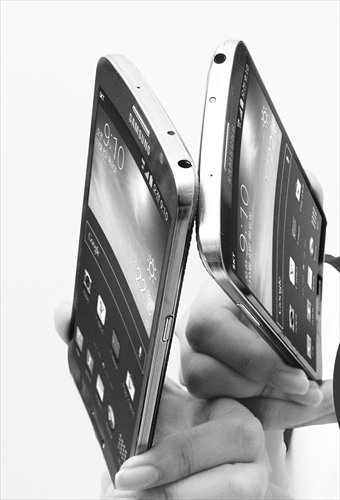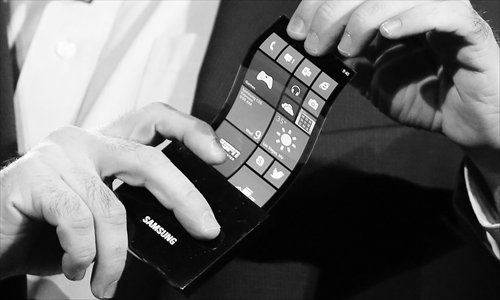HOME >> SCI-TECH
Technology rolled up into a ball
Source:Global Times Published: 2013-10-11 5:03:02

The new Galaxy Round, a smartphone with a flexible display, was launched by Samsung on Wednesday. Photo: CFP

They may not yet have the ability to be rolled up quite like a yoga mat. But the increasing maturity of flexible display technology means that your favorite gadgets: smartphones, tablets and even televisions can be carefully curled up into a ball or other surprisingly curvy shapes.
Given how superiorly thin and unbreakable the current flexible display panels already are, global market research firm IHS Inc predicts that in the future, the products will be truly bendable, rollable, foldable and even disposable - when the displays cost little enough to replace paper.
The expectations were highlighted in a June report released by the company, in which IHS' director for mobile and emerging displays and technology Vinita Jakhanwal said that the displays have the potential of "creating whole new classes of products and enabling exciting new applications that were impractical or impossible before."
The report went on to say that improvements in performance, not just flexibility functionality are also on the horizon. A more sophisticated curved surface could help keep the screen at a more preferable distance and position for the eyes, offering users a more comfortable view.
In fact, existing OLED (organic light-emitting diode) technology, applied to displays just two to three milliliters thick today, works to provide a higher-contrast image and a wider visual angle than an LCD (liquid crystal display).
IHS says that in the next seven years, the world will see exponential growth in demand for flexible displays, one that will be 250 times greater than this year's expected shipments of 3.2 million displays at 792 million displays come 2020.
The jump will result from people's desires for a broad variety of "otherworldly" devices, according to IHS.
Many companies, particularly South Korean electronics producers Samsung and LG, have shown strong ambition in the new arena, but their "fiction" products, especially large-screen ones, have had difficulty entering the mass market due to their high prices.
Unaffordable 'curves'
LG and Samsung have been showing off their flexible display prototypes over the past few years at various industry trade shows, including the popular Consumer Electronic Show. In September, they both introduced their own OLED curved TVs to Chinese audiences, after securing footholds in this part of the market in their home countries, the US and Europe.
Many tech geeks have been amazed by their curved TVs, but the challenge of producing them at affordable prices for the average TV viewer stands in the way of the gadgets taking off in the wider market.
Released on September 13 in China, LG's 55-inch OLED TV sells for 59,999 yuan ($9,804), a little more than Samsung's equivalent that was introduced three days later to Chinese buyers for 54,999 yuan.
Both products are cheaper in China than in South Korea and the US, but still nearly 10 times more than the average price of an LCD TV of the same size in the Chinese market. And that may not help with market reception, Zhang Qing, director of China Market Research at DisplaySearch, told the Global Times on Tuesday.
Moreover, the products have been underperforming in other markets. Given its high price of 11 million won ($10,000), LG sold just some 200 OLED curved TVs at home within two months of coming online in February, said media reports.
Meanwhile, South Korea media reported that rival Samsung slashed the price of its product from 15 million won to 9.9 million in August in a bid to attract more customers.
"The flexible display technology has not matured fast enough to realize mass production of large-size screens for end use, resulting in huge costs and high selling prices. This glaring high-tech TV can only be consumed by some very rich individuals at present," said Zhang.
Starting small
But the situation may be better for the unique technology when applied to smaller consumer electronic products, such as smartphones, tablets and smart watches.
Unlike TVs, the display area is not the most important aspect of a small-screen smart gadget, so such devices do not require as sophisticated a level of technology as curved TVs, said Zhang.
"This means that the cost of the smart devices won't be as affected by attaching the flexible displays to them," he said. "Given that the display only accounts for 30 percent of the entire cost of the gadget compared to TV displays where it makes up more than half of the cost, the selling price of flexible display phones or tablets will be easier for consumers to swallow."
Electronic makers, too, have sensed this, and some have taken it upon themselves to launch their own flexible display smart devices.
Among them, Samsung launched "Galaxy Round" on Wednesday, the world's first smartphone with a curved 5.7-inch display. It's available through South Korean mobile carrier SK for the price of 1.089 million won.
LG is also reported to launch "G Flex" next month, a smartphone with a 6-inch flexible display while Apple Inc is expected to unveil iWatch next year, which will apply LG's flexible OLED display technology.
Both Samsung and Apple could not be reached for interview by press time and LG declined to comment on its latest developments regarding flexible display technology when contacted by the Global Times on Tuesday.
In the coming years, IHS predicts the largest application of flexible displays for personal electronic devices to be seen, with smartphones expected to lead the segment as shipments soar from less than 2 million units this year to 351 million by 2020.
And while the thought of having this many flexible display smartphones in the market so soon is exciting, as Jessica Dolcourt, senior editor at IT news portal CNET explains, don't expect to see paper-thin mobiles that can be rolled into a ball quite yet. Some models only feature screens that are flexible, while the body of the phones remain stiff.
"If batteries and chips could become thin and flexible without influencing their durability and performance, a paper-thin foldable phone would be presented to consumers," said Zhang.
Given that batteries and chips evolve slowly, few technology firms are willing to dedicate resources to this area, meaning that paper thin phones are likely to remain a far-fetched fantasy for some time yet, he added.
"No doubt flexible display technology is awesome, but since it's so new it's hard to tell yet whether it will create new classes of products that will be widely accepted in the mass market," he said. "More time and further research is needed to figure out how to integrate user experiences."
Posted in: IT